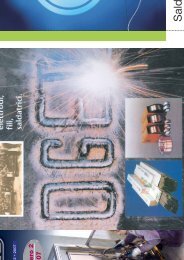Create successful ePaper yourself
Turn your PDF publications into a flip-book with our unique Google optimized e-Paper software.
E. Seib e M. Koçak - Fracture analysis of strength undermatched welds of thin-walled aluminium structures using FITNET procedure<br />
4.2.2 Fracture resistance<br />
The widely used standard for the Rcurve<br />
determination of the thin sheet<br />
material is ASTM E 561 [10] and is well<br />
established for the aerospace applications.<br />
However, the methodology given<br />
in this standard is only valid for homogeneous<br />
(unwelded) materials. The<br />
determination of the plasticity corrected<br />
effective crack length (Δa eff), as required<br />
within this standard, is not transferable<br />
to welded configurations in a straightforward<br />
manner. The plastic zone development<br />
at the tip of the crack within the<br />
weld deposit is not similar to those of the<br />
homogeneous base metal crack. The<br />
Figure 10<br />
a) CTOD δ 5 R-curves for LBW (crack in<br />
fusion zone) and FSW (nugget and<br />
TMAZ cracks) welds obtained from the<br />
respective C(T)50 specimens<br />
b) Critical events of LBW and FSW M(T)<br />
panels where the panels experienced<br />
unstable fracture<br />
98 Riv. Ital. Saldatura - n. 1 - Gennaio / Febbraio <strong>2007</strong><br />
ARAMIS method has demonstrated the<br />
confined and elongated plasticity development<br />
ahead of the undermatched weld<br />
cracks in Figures 3-5. Therefore, the<br />
standard methodology for the plastic<br />
zone size determination and hence the<br />
calculation of the effective crack extension<br />
for the cracks in strength<br />
mismatched welds needs to consider the<br />
mismatch factor (M) and the size of the<br />
weld (2H). Moreover, the current<br />
FITNET FFS Procedure needs an Rcurve<br />
in terms of a physical crack length<br />
(Δa phy). The CTOD δ 5 approach [11]<br />
offers a method for the determination of<br />
the fracture resistance curves, which is<br />
particularly suited<br />
for thin-walled structures.<br />
A specially<br />
designed clip is<br />
attached across (5.0<br />
mm gauge length)<br />
the fatigue crack tip<br />
to measure the crack<br />
tip opening displacement<br />
as the crack<br />
advances during<br />
loading.<br />
Figure 10 a) shows<br />
the fracture resistance<br />
curves in terms<br />
of CTOD δ 5 obtained<br />
for the LBW and<br />
FSW joints from the<br />
respective C (T) 50<br />
specimens with a/W<br />
= 0.5 using the<br />
multiple specimen<br />
technique. Antibuckling<br />
guides were<br />
used to ensure the<br />
Mode I type loading<br />
during the testing of<br />
the C(T)50 specimens.<br />
The R-curve<br />
for the LBW weld<br />
exhibited the lowest,<br />
whereas for the FSW<br />
joint with a crack in<br />
the nugget area the<br />
highest R-curve.<br />
Figure 10 b) depicts<br />
the critical CTOD δ 5<br />
values at the final<br />
failure, being also the<br />
maximum load, of<br />
corresponding stable<br />
crack extension. It<br />
can be seen that these<br />
values lie on the curve fits of the respective<br />
C(T)50 specimens indicating the<br />
geometry independence of these fracture<br />
resistance curves.<br />
4.3 Component related input data<br />
4.3.1 K-factor solution<br />
The K-factor for a middle cracked M(T)<br />
panel is available in a closed form solution<br />
[12]:<br />
where<br />
(17)<br />
F is the applied load,<br />
2W is the total panel width,<br />
a is the half crack length, and<br />
B is the panel thickness (B = 2.6 mm<br />
for LBW and B = 2.2 mm for FSW).<br />
Since K is a purely geometrical function,<br />
it is also valid for heterogeneous configurations<br />
like welded panels.<br />
4.3.2 Yield load solution<br />
The second component related input<br />
parameter of the FITNEY FFS flaw<br />
assessment procedure is the mismatch<br />
corrected yield load solution, F YM,<br />
which has already been presented in the<br />
previous section and given according to<br />
[6] as:<br />
[see (3)]<br />
Note that this solution is only valid for<br />
highly undermatched welds where the<br />
plastic deformation at the crack tip<br />
located in the weld does not penetrate<br />
into the base material. This consideration<br />
is specifically applicable to both<br />
LBW and FSW butt joints of 6xxx series<br />
Al-alloys.<br />
5. FITNET prediction of the load<br />
carrying capacities of the<br />
welded M(T) panels<br />
The input information needed for the<br />
application of the FITNET FFS Procedure<br />
- Fracture Module (see Figure 7) is<br />
presented in previous sections.





